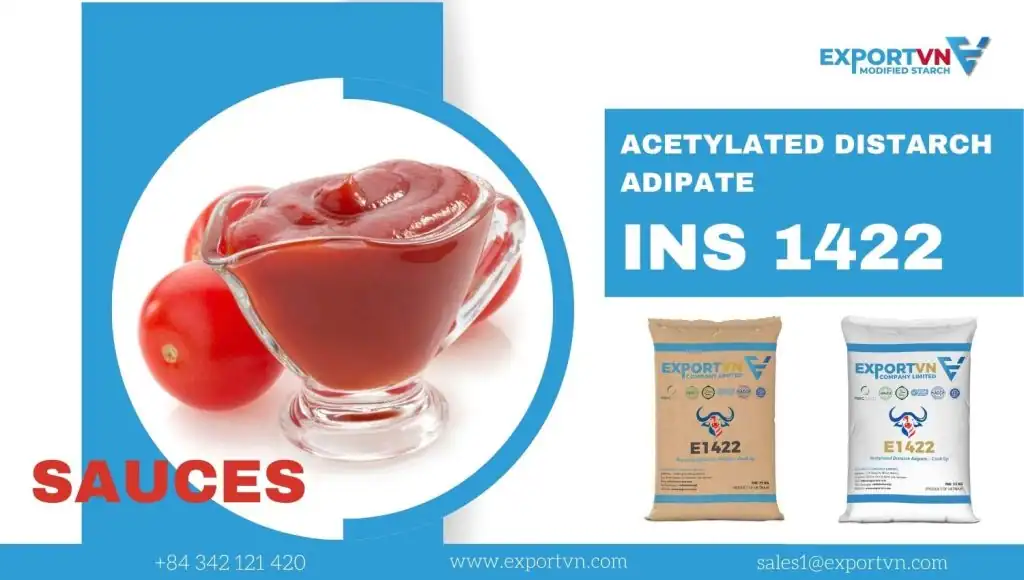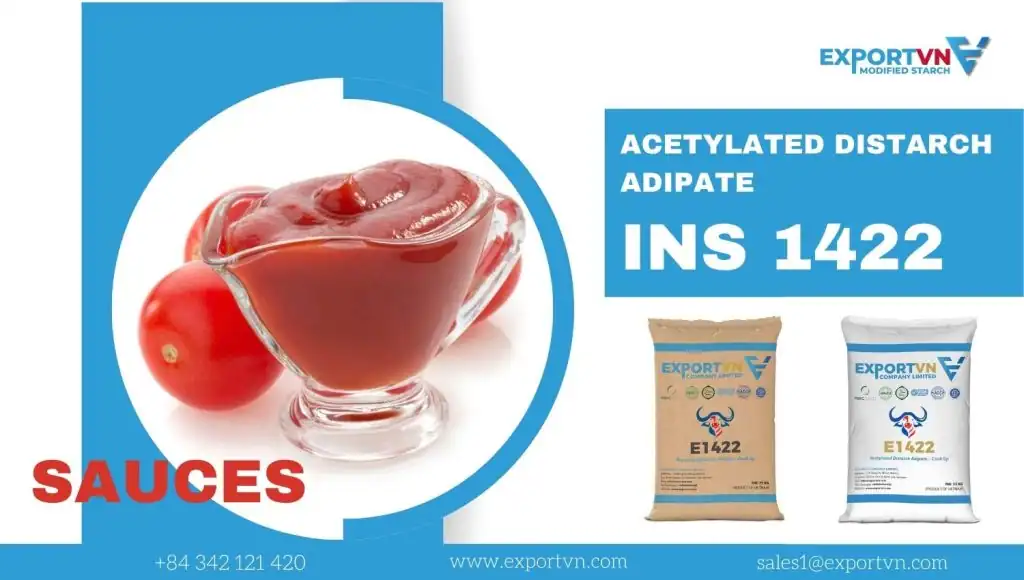What is E1422
E1422, also known as Acetylated Distarch Adipate, is a type of modified starch widely used in the food industry for its stability and versatility. It is made by chemically altering native starch, usually derived from maize, tapioca, or potato, to improve its performance in various processing and storage conditions.
Chemical description and classification
- Classification: Modified starch
- Chemical name: Acetylated Distarch Adipate
- E number: E1422
- Structure: Starch molecules cross-linked with adipic anhydride and further modified with acetic anhydride
- Function: Thickener, stabiliser, texture enhancer
How E1422 is produced
The production of E1422 involves two main processes:
- Cross-linking: Starch granules are treated with adipic anhydride to create covalent bonds between starch chains. This improves stability against heat, acid, and mechanical shear.
- Acetylation: Acetic anhydride is used to add acetyl groups to the starch, enhancing freeze–thaw resistance and water-binding capacity.
This modification changes the gelatinisation behaviour of starch, making it more functional in complex recipes.
Comparison with other modified starches
| Starch Type | Main Modification Method | Key Functional Benefit |
|---|---|---|
| E1422 Acetylated Distarch Adipate | Cross-linking + acetylation | Superior freeze–thaw stability, high resistance to heat and acid |
| E1442 Hydroxypropyl Distarch Phosphate | Cross-linking + hydroxypropylation | Excellent freeze–thaw stability, smooth texture |
| E1404 Oxidised Starch | Oxidation | Lower viscosity, good film-forming properties |
| Native Starch | None | Thickening, but poor process stability |
Compared to other modified starches, E1422 offers a balance of high stability, smooth mouthfeel, and moisture retention, making it an ideal choice for frozen or processed foods.
Functional properties of E1422 in food

E1422, also known as acetylated distarch adipate, is valued in the UK food industry for its reliable and versatile functions. Its key benefits come from its ability to work as both a thickener and a stabiliser, delivering consistent results across a wide range of recipes.
Thickening and consistency
E1422 increases viscosity without giving food a sticky or gluey feel. It helps sauces, soups, pie fillings, and dairy-based desserts hold their body, even after cooking or reheating.
Stabiliser and emulsifier roles
It prevents separation in products where water and fat naturally split, such as salad dressings, sauces, and ready-made gravies. It holds emulsions steady during storage and transport.
Texture and mouthfeel
It gives a smooth, creamy texture to dairy products, bakery fillings, and processed meats, making them more appealing to eat.
Water retention and moisture control
E1422 helps food maintain moisture during storage and cooking. This is especially important for baked goods, processed meats, and microwave-ready meals, keeping them soft and succulent for longer.
Enhanced freeze–thaw stability
Frozen products often suffer from water separation or texture breakdown. E1422 resists these changes, so items like frozen desserts, pastries, and sauces maintain their quality after defrosting.
Applications of E1422 in Various Food Products
E1422, also known as acetylated distarch adipate, is widely used across the UK food industry for its stability, thickening, and texture‑enhancing properties. It performs well in both hot and cold conditions, making it suitable for a wide range of products.
Bakery products
In bread, cakes, pastries, and other baked goods, E1422 helps maintain softness, improves crumb structure, and slows staling. It also supports moisture retention, which is key for products with a longer shelf life.
Dairy products
In yoghurts, custards, and processed cheeses, E1422 acts as a stabiliser to prevent separation. It gives a smooth, consistent texture and helps products hold their shape, especially during chilled storage.
Meat products
For sausages, pies, and plant‑based meat alternatives, E1422 helps bind water and fat, improving juiciness and texture. It also increases freeze–thaw stability, making it ideal for frozen meat lines.
Sauces, dressings and soups
E1422 thickens without clumping and keeps emulsions stable. Whether it’s a salad dressing, gravy, or cream‑style soup, it helps maintain a glossy, even texture while resisting breakdown during reheating.
Ready to eat and convenience foods
Microwave meals, frozen ready meals, and meal kits often use E1422 for consistent texture after storage, transport, and rapid heating. It keeps sauces smooth and prevents watery separation.
Gluten free food formulations
In gluten‑free baking and snacks, E1422 replaces some of the binding and texturing roles of gluten. It helps maintain structure, improves mouthfeel, and reduces crumbling in products like biscuits, muffins, and wraps.
Benefits of Using E1422 in Food Processing
E1422, also called acetylated distarch adipate, is widely used in UK food manufacturing for its ability to handle harsh processing, keep products stable, and maintain quality for longer. Here’s why it’s valued in day‑to‑day production.
Longer Shelf Life and Stability
- Helps products hold texture and consistency over time.
- Reduces separation in liquids like sauces and dressings.
- Maintains structure in frozen and chilled goods, even after repeated freeze‑thaw cycles.
Cost Effectiveness and Efficiency
- Works at lower inclusion levels compared to some alternatives, keeping ingredient costs down.
- Cuts down waste by preventing quality loss in storage and transport.
- Performs reliably under varying cooking and storage conditions, reducing production issues.
Improved Sensory Properties
- Enhances smoothness, creaminess, and clean mouthfeel.
- Keeps colours and visual appeal stable through processing.
- Supports desirable textures in both bakery and dairy products.
Strong Resistance to Processing Stresses
- Tolerates high‑heat cooking, retorting, and baking without breaking down.
- Withstands acidic conditions in products like fruit fillings and dressings.
| Benefit | Impact on Product |
|---|---|
| Shelf life extension | Less spoilage, longer time on shelves |
| Cost efficiency | Lower ingredient spend, fewer production losses |
| Better sensory qualities | More appealing texture, appearance, and taste |
| Process resilience | Reliable performance in extreme heat, cold, or acidity |
Regulatory Status and Safety of E1422
E1422, better known as acetylated distarch adipate, is widely approved for use as a modified starch in foods. It’s recognised as safe by major food safety agencies, including the European Food Safety Authority (EFSA), the US Food and Drug Administration (FDA), and Codex Alimentarius. In the UK, it’s classed as a permitted food additive and used under the “modified starch” category.
Approval and Usage Levels
- EFSA & UK Regulations – Assessed for safety, with no specific numerical acceptable daily intake (ADI) set when used within good manufacturing practice.
- Codex Alimentarius – Authorised in a range of food categories with application-specific limits.
- FDA – Approved for use in foods in line with industry-standard processing levels.
Safety and Health Considerations
Safety studies have shown E1422 is not linked to harmful health effects when consumed at permitted levels. It’s considered non-toxic, non-carcinogenic, and is digested in much the same way as native starch. For most consumers, it has no known negative impact.
Allergen and Labelling Requirements
- Allergen Status – E1422 does not commonly cause allergic reactions and is not among the 14 major allergens that require mandatory declaration in the UK.
- Labelling – On UK food labels, it must be listed either as “Modified Starch (E1422)” or “Acetylated Distarch Adipate”. This gives transparency for consumers, particularly those watching additive intake.
With strict regulatory checks and established safety profiles, E1422 remains a trusted thickener and stabiliser in a wide range of food products across the UK market.
How to Use E1422 Effectively in Formulations

Getting the most from modified starch E1422 (acetylated distarch adipate) in food manufacturing comes down to knowing how it behaves in different recipes. E1422 is dependable for thickening, stabilising and improving texture, but using it the right way avoids processing issues and keeps quality consistent.
Best Practices for Incorporation
- Pre-blend with dry ingredients before adding to liquids to prevent lumping.
- Hydrate in cold or warm water for even dispersion, then apply heat if needed for full viscosity development.
- Add gradually while mixing to allow uniform distribution.
- Adjust addition point depending on your cooking process – in some cases, late-stage addition helps retain viscosity.
Adjusting Water and Fat Content
E1422 affects how water and fat behave in recipes. It can hold more water than native starch, which means:
- You may reduce added water slightly in batters or dough.
- In emulsions and creamy products, fat content can be lowered without losing mouthfeel.
- In low-fat products, E1422 helps prevent watery separation during shelf life.
Interaction with Other Ingredients
- Works well alongside proteins, gums and hydrocolloids, but check for viscosity changes if combining with high levels of guar or xanthan gum.
- Acidic environments (e.g. fruit fillings, dressings) are fine, but prolonged high heat with strong acids may slightly reduce thickness.
- Compatible with most sugars and salts, making it versatile for both sweet and savoury applications.
Trends and Innovations Involving E1422
E1422 (acetylated distarch adipate) is seeing new uses as food manufacturers in the UK adapt to consumer demand for cleaner, more sustainable products.
Use in plant based and clean label products
With the rise of plant-based foods, E1422 is valued for giving dairy-free yoghurts, vegan sauces, and meat alternatives the same smooth texture and stability as their traditional counterparts. For clean label recipes, suppliers are now focusing on sourcing starch from non-GM crops and offering versions suited to “no artificial additives” claims.
Advances in modified starch technologies
Recent developments mean E1422 can be tailored for different processing needs — whether for high-shear cooking, acidic sauces, or frozen–thawed products. There’s also work on improving performance at lower dosage levels, helping to cut formulation costs while keeping texture and stability strong.
Sustainable sourcing and production
UK and EU brands are under pressure to reduce their environmental footprint. Starch producers are working on more sustainable crop sourcing, increasing yield efficiency, and reducing water and energy use during modification. Some suppliers are also exploring local UK-grown starch sources to lower transport impact.
Role in reducing food waste
Thanks to its excellent freeze–thaw stability and water-binding properties, E1422 helps products keep their quality for longer, even after freezing and reheating. This reduces spoilage across supply chains, making it useful for ready meals, bakery goods, and frozen desserts where texture and freshness can otherwise decline.
Why Choose Taichy Food for E1422
When it comes to sourcing modified starch E1422 for the UK food industry, Taichy Food offers a strong balance of quality, reliability, and flexibility. Here’s why many manufacturers work with us:
Quality Assurance and Product Standards
We supply acetylated distarch adipate that meets both UK and international safety standards, including EFSA and Codex Alimentarius requirements. Every batch goes through strict quality control to ensure:
- Consistent performance in processing.
- Compliance with regulatory limits.
- Stable texture and thickening quality.
| Standard | Certification | Benefit for Clients |
|---|---|---|
| EFSA compliant | Yes | Legal assurance for EU/UK markets |
| ISO certified | Yes | Consistent quality year-round |
| Batch traceability | 100% | Full production transparency |
Customisation and Technical Support
Different products require different starch performance. We provide:
- Tailored E1422 specifications for bakery, dairy, sauces, meat products, and gluten-free ranges.
- Technical support to adjust recipes for desired viscosity, freeze–thaw stability, and mouthfeel.
- On-site or remote assistance for trial runs.
Innovation and Sustainability
We invest in modified starch technologies that align with the UK’s sustainability goals. Our focus areas include:
- Sourcing raw starch from sustainable farming.
- Optimising production to reduce waste and energy use.
- Supporting plant-based and clean-label product development.
With Taichy Food, UK manufacturers can count on dependable supply, expert formulation advice, and a partner who understands both the technical and market demands of E1422 food starch stabiliser applications.


